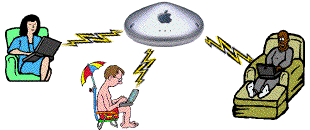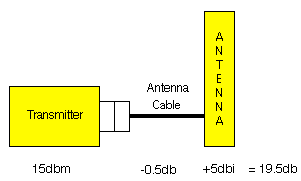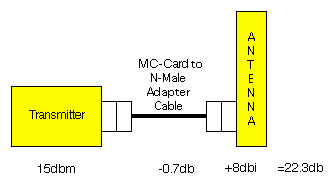Antenna Discussion:
By definition, antennas are a passive means to increase the coverage of your transmitter in one direction at the expense of coverage in another. Thus, adding an antenna does not increase the current draw of your transmitter. Instead, an antenna trades sensitivity/power in one direction for more sensitivity/power in another.
You can amplify the signal electronically, but doing so is expensive (amplifiers typically cost more than a new base station) and you'll still need an external antenna. So if you can design a system without the need for an amplifier, you're probably better off financially. Furthermore, amplifiers can quickly push the output of your system beyond the limits of legally unlicensed operation.
Please note that while I have compiled the following to the best of my abilities, I'm not an Radio-Frequency (RF) engineer and anything you do as a result of this page is at your risk alone. Furthermore, you would be well advised to know and understand any relevant laws in your jurisdiction before you modify a certified product. So, first some background information:
- Decibel (db)
- The decibel measure is used quite frequently in engineering because it simplifies calculations a lot when one deals with wide data ranges. In this case, it allows engineers to linearize a exponential function and simplify calculations. Every time you double transmission power, the output increases by 3 db.
In RF applications, the decibel measure is very popular because it allows you to easily calculate the cumulative effects of several different components in your system: Transmission Power, Receiver Sensitivity, Antenna Gain, and the Effective Isotropic Radiation Power of a radio transmitter. - Transmission Power (measured in db milliWatts or dbm)
- Transmitters are usually rated by their output in Watts (or milliWatts in the case of 2.4GHz wireless networks). You can then convert milliwatts into exponential dbm measure. Thus, while a 500mW transmitter has a output of 27dbm, its 1W cousin puts out 30dbm. Currently, the amplifiers found in 2.4GHz wireless PC cards have a output between 15dbm (30mW) and 23 dbm (200mW), depending on the model.
- Receiver Sensitivity (measured in -dbm)
- However, transmittive power is not everything. In order to be effective, your wireless LAN card also has to receive signals well. The Sensitivity of your receiver is a measure of how good a receiver is at separating a signal from background noise. While many manufacturers share the same underlying chip-sets, differences in antenna design and firmware can have a profound effect on the actual performance of cards.
- Antenna Gain (measured in dbi)
- Similarly, dbi are used to calculate antenna gain, a measure of how much more sensitive an antenna is over a isotropic antenna (an antenna that radiates equally in all directions). A isotropic antenna has zero gain, while highly directional antennas can achieve gains of up to 24dbi.
- Antenna Cable Losses
- The choice of a antenna cable can have a significant impact on the performance of your wireless system. Simply put, 2.4GHz signals have a very hard time with the thin coaxial wires necessitated by the MC-Card connectors found on Airport cards. Over the course of the six-foot long antenna cables commonly found attached to ready-made antennas, 3db or 50% of the signal will be lost through attenuation.
Manufacturer Cable Designation Jacket Material/Color OD Braid Coverage Attenuation (db/ft @ 2.4-2.5 GHz) Commscope WBC-100 PVC/Black 0.1" 90% 0.39-0.40 Nexans RG 316 LSZH ?? 0.1" 90% est. 0.43 Belden RG 188A Teflon/White 0.1" 96% est. 0.43 Times Microwave LMR100A PVC/black 0.1" 100% 0.39 Times Microwave TFlex405 FEP/blue 0.11" 100% 0.34 Times Microwave LMR200 PE/black 0.2" 100% 0.17 Times Microwave LMR400 PE/black 0.4" 100% 0.07
So even short lengths of 0.11" or less thick MC-Card connector compatible antenna wire will lead to considerable signal losses. Furthermore, every connector in the system adds another 0.15db of attenuation loss. Thus, your aim should be to minimize the length of the antenna cable and the number of connectors. Of the above wires, the TFlex-405 is the best choice for MC-Card connectors. However, few merchants mention what wires they use in their assemblies and even fewer publish the total loss.
What is the moral of the story? Ideally, buy antennas with very short leads (19 inches or less) or resort to the use of 12" long "Pigtails" in combination with a standard antenna that features a built-in N-Female connector. - Pigtail
- A Pigtail is basically a converter cable that allows you to "jump" from one type of connector to another. Typically, Pigtails will make connections between the myriad of "proprietary" connectors (like the MC-Card variety found on Airport cards) and the industry-standard N-Male connector (which also happens to be much bigger!). Why is there a myriad of proprietary connectors? Because FCC regulations mandate it...
Anyway, the beauty of going with a standard N-Male plus is that there is a huge universe of antennas out there that have the corresponding N-Female plug on them. They tend to be more available and their prices tend to be lower because they are more of a commodity. - Effective Isotropic Radiated Power (EIRP)
- Most governments limit the output of unlicensed radio transmitters. The EIRP is simply a measure that combines the power of the transmitter with Antenna Gain minus Antenna Cable and Connector losses. Since all measures use decibels, you can simply add transmitter power and antenna gain and subtract cable & connector losses to derive the EIRP of your wireless system.
In the USA, the FCC has set a limit of 36dbm in the 2.4GHz band (i.e. 4 Watts) for multi-point operations. In the UK, the EIRP limit is a much lower 20dbm (i.e. 100 mW). Thanks to the folks at the Computer Support Group, you can use a Java-based online EIRP calculator to discover what transmitter and antenna combinations are legal in your jurisdiction. - Point to Multi-Point Operation
 Your base station is a point-to-multi-point network right out of the box. While you roam around the house with your laptop, the base station does not move.
It can handle up to 50 clients and the only real limitation is the bandwidth they have to share.
Your base station is a point-to-multi-point network right out of the box. While you roam around the house with your laptop, the base station does not move.
It can handle up to 50 clients and the only real limitation is the bandwidth they have to share.
The reason most people want to add an antenna to this sort of network is to increase it's usable range. For example, there may be that favorite spot in the garden that your current base station doesn't cover.
Usually, such networks work best with so-called "omni-directional" antennas that increase horizontal coverage at the expense of vertical coverage. Click here to see how omni-directional antennas work and which one to buy for your base station. However, you may also elect to use a low-gain directional antenna to let a fixed computer connect to a multi-point ABS or even for the ABS as a passive means of increasing security.- Point to Point Operation
 Point-to-Point networks consist of two (typically fixed) transmitters that only talk to each other over large distances. They achieve great range by using highly directional antennas. In this illustration, I show a wireless "bridge" between two base-stations. However, the transmitter attached to the antenna is arbitrary, it can be a base station or a computer. Point-to-Point networks are useful at bridging large distances where using cables is unpractical or very expensive.
Point-to-Point networks consist of two (typically fixed) transmitters that only talk to each other over large distances. They achieve great range by using highly directional antennas. In this illustration, I show a wireless "bridge" between two base-stations. However, the transmitter attached to the antenna is arbitrary, it can be a base station or a computer. Point-to-Point networks are useful at bridging large distances where using cables is unpractical or very expensive.
For example, many telephone networks in remote areas rely on micro-wave towers to cover large distances. Or, your local internet provider may not be able to reach your house as described here by Mr. Cringely. Point-to-Point networks benefit from high-gain directional antennas. Click here to see what directional antennas do and which one to buy for your system.- The Simplest Antenna Retrofit:
 In theory, the diagram at left is the least "lossy" way to hook up an external antenna because it omits one connector. In the example at left, I am assuming a short (12" long), high quality antenna wire. Most antennas with built-in antenna cables do not meet this standard (longer lengths and/or lower quality of antenna wire results in greater attenuation).
In theory, the diagram at left is the least "lossy" way to hook up an external antenna because it omits one connector. In the example at left, I am assuming a short (12" long), high quality antenna wire. Most antennas with built-in antenna cables do not meet this standard (longer lengths and/or lower quality of antenna wire results in greater attenuation).
For example, 5 foot long antenna cables like the ones found on the 5dbi Lucent "Extender Antenna" have a stated loss of 2.5db or almost 50% of the signal! Thus, while the Lucent Extender Antenna will boost EIRP to 17.5db (15dbm - 2.5 + 5dbi = 17.5db, a theoretical 50% increase in power), its performance could be much better. Furthermore, this EIRP increase only corresponds to a 15-30% indoor improvement in real life.- Standard Antenna and Pigtail Retrofit
 A "pigtail" or adapter cable that allows you to convert from the connector found on your transmitter to the industry-standard "N-Male" plug. Hence, you will have a much wider set of antennas to chose from than if you try to buy an antenna with the specialized plug installed already. Furthermore, pigtails are usually available in lengths as short as 12 inches (~30cm) - thus, cable quality becomes less of issue because it's so short.
A "pigtail" or adapter cable that allows you to convert from the connector found on your transmitter to the industry-standard "N-Male" plug. Hence, you will have a much wider set of antennas to chose from than if you try to buy an antenna with the specialized plug installed already. Furthermore, pigtails are usually available in lengths as short as 12 inches (~30cm) - thus, cable quality becomes less of issue because it's so short.
The additional connector does add losses to the equation, though at a typical 0.1-0.2db per connector, they are not excessive. In the example at right, I show a WaveLAN card hooked to a 8dbi antenna, for a net 7.3db of gain after losses. This results in about 125% more effective power, though the actual indoor range doesn't increase nearly as much. On the other hand, this is a much better result than what could have been achieved with the OEM Lucent Extender antenna at the same cost. For those of us that require even more power than antennas alone can satisfy, an electronic amplifier might be in order.- The Power User Option: Going with an Amplifier

"Power Users" might opt to add a two-way amplifier to their antenna. With amplifiers you can easily reach the legal limits of unlicensed transmission. But amplifiers are usually quite expensive and work better at boosting the outgoing signal than amplifying the incoming signal. Thus, they are most useful in applications where you don't upload as much from mobile clients as you download to them. See my Amplifier Page for more information if you're seriously contemplating the use of a amplifier.- What is the Power of my Airport Base Station?
Second Generation "Airport" PC-cards found in "Snow" base stations rely on external antennas. The stated EIRP of a "Snow" base station is 15db, though no mention is made how Apple got there. Adding to the mystery, the small circuit board found just upstream of the actual antenna in "Snow" base stations probably serves as an amplifier. Several readers have contributed their thoughts as to what these boards in Snow and Extreme base stations do.
The current "Airport Extreme" and "Airport Express" hardware also has a stated EIRP of 15dbm. Once again, I am unclear what the exact transmitter output, amplifier gain, or antenna gain are. Thus, if you plan to retrofit a new antenna, you may be facing an uphill battle if you plan to bypass the circuit board and plug directly into the MC-Card connector. If you can identify the components on either board, please e-mail me!

